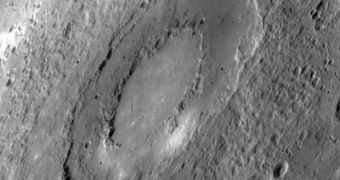Yesterday, NASA's MErcury Surface, Space ENvironment, GEochemistry and Ranging spacecraft (MESSENGER) did its third and final flyby of Mercury, before its 2011 orbital insertion date. During the approach, areas of the planet that had never before been imaged were analyzed, but the success of the mission was diminished by a small glitch the probe suffered while on approach. It may be that some images were lost, or never taken, and mission controllers are unsure if any photographs were snapped as the craft flew away from the innermost planet, Space reports.
The lowest point in MESSENGER's flight was achieved shortly before 5:55 pm EDT (2155 GMT). The craft flew about 228 kilometers (141 miles) above the surface of the planet, and it has already sent back some pictures it took during the approach. In addition to being the final observation run above the planet, yesterday's event was also an elegant gravity assist maneuver that set the probe on the correct path to orbital insertion. After it makes a few more rounds around the Sun, the device will be captured in Mercury's orbit starting with 2011, and will begin to make constant, scientific observations of the surface.
“We do have some new science from the flyby. We missed a little icing on the cake. What is important is that the spacecraft and the instruments are healthy. We're all working through this,” Johns Hopkins University (JHU) Applied Physics Laboratory (APL) expert and MESSENGER project scientist Ralph McNutt says of the glitch. Most of the new images were, however, taken during the inbound leg of the flyby, and it's still unknown how many, if any, photos were snapped during the outbound leg. The craft was traveling at about 12,000 miles per hour (19,312 kilometers per hour) when it made its close approach.
The probe was launched in 2004, and it had to undergo a fairly complex procedure before orbital insertion could be achieved. This is evidenced by the seven years that will have passed by 2011, when the final stage of the mission is scheduled to begin. After it took off, from the Space Launch Complex 17-A, at the Cape Canaveral Air Force Station, in Florida, MESSENGER had to perform one Earth swing and two Venus swings before gathering enough speed to enter its correct path for the three flybys. Now, after the final one is done, the craft is set on a course that will take it to orbit in about two years.

 14 DAY TRIAL //
14 DAY TRIAL //